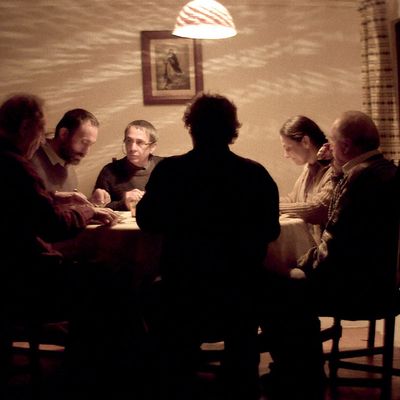
In Tom McCarthy’s Oscar contender Spotlight, there’s a scene where one of the film’s crusading journalists, played by Brian D’Arcy James, discovers that a house in his neighborhood is being used by the Catholic Church to house disgraced priests accused of molesting children. It’s a chilling moment, but also an odd one: In a film that’s otherwise quite generous with its characterizations and meticulous in its narrative, it’s weird to have an element like that turn up, like some kind of grisly, real-world haunted house. Watching the otherwise excellent Spotlight, I found myself wondering about what exactly goes on in a sad, condemned place like that.
And now, as if on cue, comes Pablo Larrain’s disturbing film The Club, which is set in and around a small home for disgraced priests in a remote seaside village in Chile. The men, who appear to be overseen by one outwardly pleasant but ruthlessly efficient nun, Sister Monica (Antonia Zegers), spend their days eating, praying, walking the beach, and training their beloved greyhound. They’re not allowed to spend much time alone, or in town; Sister Monica is soft-spoken and helpful, but she also keeps them on a tight leash. Larrain shoots in muted colors and soft light, and the quiet, curiously desolate surroundings feel hesitant, temporary, unreal. Which makes sense: This is a place for people nobody knows what to do with — a land of physical and spiritual exile.
One day, a strange drifter shows up outside the house and starts to bellow drunkenly, in explicit and gruesome detail, about the horrific abuse he experienced as a child at the hands of one of the priests. (How did he even find this place in the middle of nowhere? One does not ask such questions of elliptical, symbolic movies.) The outcome of that confrontation — which I will not give away here — results in a visit from a younger Church emissary, Father Garcia (Marcelo Alonso), who begins to grill the men about what happened, and about what they’re there for. We begin to understand that the men are guilty of a variety of crimes: one took children from mothers to give to other families (among the more grotesque crimes perpetrated during the Pinochet dictatorship in Chile). One claims to have memorized the confessions of soldiers who tortured and murdered civilians during the dictatorship.
Larrain shoots these exchanges in frontal close-ups, so that the characters almost seem to address the camera. It works with the general austerity of his approach (and it evokes the frontality of religious icons), but it also adds to our unease. Especially because we don’t quite know the reason for Father Garcia’s visit. Is he there to bring one of the priests back to the public, as a sacrificial lamb? Is he there to help them? To close down the house and cast them into the wind? The men all distrust Garcia — “You’re a Vatican bureaucrat who flies first class and stays in five-star hotels,” one of them says, before correctly identifying Garcia’s fancy cologne. “How long have you been in a parish with poor people?” The push-pull of identification here is almost nauseatingly discomfiting as it goes back and forth: We sometimes feel bad for these seemingly helpless, broken monsters, but we also can’t help but understand Father Garcia when he responds to one of their desperate admonishments with a very calm, “Has it ever occurred to you that you’re a criminal?”
What to make of a movie like this? The Club isn’t really about molestation or politics so much as it is about the mysterious netherworld of guilt, shame, fear, and righteousness, and how those things sometimes become tangled together. It’s occasionally beautiful, but just as often stomach-turning. You watch it at a remove, but still with a dull combination of pity and horror and regret. Maybe that’s the idea. For a brief, agonizing moment, you share the spiritual quicksand with these disgraced men.


